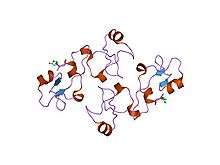Trefoil domain
| Trefoil (P-type) domain | |||||||||
|---|---|---|---|---|---|---|---|---|---|
 Structure of pancreatic spasmolytic polypeptide.[1] | |||||||||
| Identifiers | |||||||||
| Symbol | Trefoil | ||||||||
| Pfam | PF00088 | ||||||||
| InterPro | IPR000519 | ||||||||
| SMART | SM00018 | ||||||||
| PROSITE | PDOC00024 | ||||||||
| SCOP | 1psp | ||||||||
| SUPERFAMILY | 1psp | ||||||||
| CDD | cd00111 | ||||||||
| |||||||||
Trefoil (P-type) domain is a cysteine-rich domain of approximately forty five amino-acid residues has been found in some extracellular eukaryotic proteins.[2][3][4][5] It is known as either the 'P', 'trefoil' or 'TFF' domain, and contains six cysteines linked by three disulphide bonds with connectivity 1-5, 2-4, 3-6.
The domain has been found in a variety of extracellular eukaryotic proteins,[2][4][5] including protein pS2 (TFF1) a protein secreted by the stomach mucosa; spasmolytic polypeptide (SP) (TFF2), a protein of about 115 residues that inhibits gastrointestinal motility and gastric acid secretion; intestinal trefoil factor (ITF) (TFF3); Xenopus laevis stomach proteins xP1 and xP4; xenopus integumentary mucins A.1 (preprospasmolysin) and C.1, proteins which may be involved in defense against microbial infections by protecting the epithelia from the external environment; xenopus skin protein xp2 (or APEG); Zona pellucida sperm-binding protein B (ZP-B); intestinal sucrase-isomaltase (EC 3.2.1.48 / EC 3.2.1.10), a vertebrate membrane bound, multifunctional enzyme complex which hydrolyzes sucrose, maltose and isomaltose; and lysosomal alpha-glucosidase (EC 3.2.1.20).
Examples
Human gene encoding proteins containing the trefoil domain include:
References
- ↑ Gajhede M, Petersen TN, Henriksen A, et al. (December 1993). "Pancreatic spasmolytic polypeptide: first three-dimensional structure of a member of the mammalian trefoil family of peptides". Structure. 1 (4): 253–62. doi:10.1016/0969-2126(93)90014-8. PMID 8081739.
- 1 2 Otto B, Wright N (1994). "Trefoil peptides. Coming up clover". Curr. Biol. 4 (9): 835–838. doi:10.1016/S0960-9822(00)00186-X. PMID 7820556.
- ↑ Thim L, Wright NA, Hoffmann W, Otto WR, Rio MC (1997). "Rolling in the clover: trefoil factor family (TFF)-domain peptides, cell migration and cancer". FEBS Lett. 408 (2): 121–123. doi:10.1016/S0014-5793(97)00424-9. PMID 9187350.
- 1 2 Bork P (1993). "A trefoil domain in the major rabbit zona pellucida protein". Protein Sci. 2 (4): 669–670. doi:10.1002/pro.5560020417. PMC 2142363
 . PMID 8518738.
. PMID 8518738. - 1 2 Hoffmann W, Hauser F (1993). "The P-domain or trefoil motif: a role in renewal and pathology of mucous epithelia?". Trends Biochem. Sci. 18 (7): 239–243. doi:10.1016/0968-0004(93)90170-R. PMID 8267796.
This article incorporates text from the public domain Pfam and InterPro IPR000519